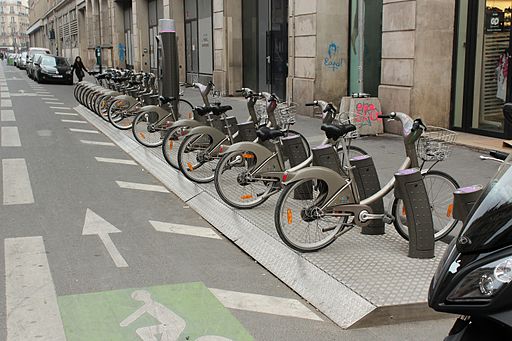E-bikes: the next big trend in bike share?
by Stefani Cox
February 16, 2018
 Source: Coyau / Wikimedia Commons, via Wikimedia Commons
Source: Coyau / Wikimedia Commons, via Wikimedia Commons
The newest trend in bike share hardware is the electric bike, and with the potential to make getting around that much easier, it’s not hard to see why.
Numerous cities in the U.S. are in the process of either beginning a bike share system with e-bikes or adding e-bikes to their original bike share fleet. A recent webinar by Bikes Make Life Better and PeopleForBikes provides a background understanding of what e-bikes are and how they fit onto streets.
Today we’ll review the webinar (entitled “E-Bikes: A bike commuting game changer”), and next week we’ll dive into conversations with Providence, Rhode Island, and Sacramento, California, who are both planning e-bike share systems.
What are e-bikes?
The webinar first took on the question of what e-bikes are in the first place and how to think about them.
Morgan Lommele, the E-Bikes Campaign Manager for PeopleForBikes, explained that e-bikes often look the same or quite similar to regular bikes. She shared that there are currently three main classifications that e-bikes come in, depending on their maximum speeds and type of assist.
Lommele said that, while the U.S. may be more familiar with a recreational experience of cycling, e-bikes can help add to transportation commuting options.
Use and behavior with e-bikes
While research might not yet be bountiful, fortunately, there are starting to be more studies that examine ridership and behavioral patterns of e-bike users.
The studies that Lommele cited showed gradually-increasing diversity in age and income distribution for e-bike purchasers. Older e-bike riders tended to use them as a way to get over physical limitations, while younger riders often used them to replace car trips.
While the perception of e-bikes might be that such vehicles travel much faster than regular bikes, Lommele said that real-time studies showed these bikes only going an average of 2-3 miles per hour faster than traditional bikes
In fact, in a 2017 test in Jefferson County, Colorado 71% of trail users didn’t even notice e-bikes sharing the path with them, when asked about their experience after e-bike “ghost riders” went by. Two-thirds of the trail users noted a positive change in their perceptions toward e-bikes as a result.
Benefits and challenges for bike share
Now, let’s take a look at what e-bikes could mean specifically for bike share.
According to Lommele’s information, bike share users who come to a dock without an e-bike (in a system that has e-bikes) will walk a quarter mile or more to access one, instead of taking out a regular bicycle. So, there is a clear interest and preference among many users for e-bikes.
Once on an e-bike, there’s a big difference in average trip distance when compared to a traditional bike — 9 miles to 1.9 miles, respectively. So e-bikes could potentially help users get further faster and with heavier cargo. It could also be useful for those with physical limitations.
However, there are still a number of challenges. The biggest systemic issue is how such bikes will be maintained and charged when part of a bike share system. Batteries need to be switched out for freshly-charged ones when they run down. And cities who use e-bike share systems may need to think about how to set up a network of charging ports to keep everything running smoothly.
One webinar participant also asked about the decreased health benefit of riding e-bikes over traditional bikes. While even e-bikes offer some fitness benefits over a sedentary lifestyle, it is true that the overall level of physical challenge is much lower. These will be important questions for cities and the bike share industry to engage with moving forward.
Stay tuned for the second half of this conversation on e-bikes next week!
The Better Bike Share Partnership is funded by The JPB Foundation as a collaborative between the City of Philadelphia, the Bicycle Coalition of Greater Philadelphia, the National Association of City Transportation Officials (NACTO) and the PeopleForBikes Foundation to build equitable and replicable bike share systems. Follow us on Facebook, Twitter and Instagram or sign up for our weekly newsletter.
